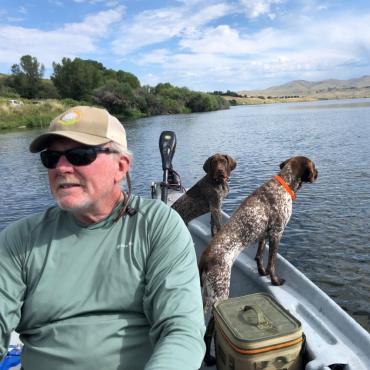Eat Your Keep
Restoring native trout through catch-and-kill.
Last week, I killed a trout. In fact, I killed three and ate them for dinner. As a longtime catch-and-release angler, it’s always difficult to kill a fish. In this case, I was fishing a stream where non-native rainbows are slowly taking over the native cutthroat. I’ve watched this progression for years: more and more rainbows and rainbow-cutthroat hybrids and fewer pure cutthroat trout. This probably wouldn’t bother me so much except that there just aren’t many rivers left where you can regularly catch a native cutthroat. I’ve heard all the arguments about wild fish being wild fish and how rainbows are better fighters and big browns are the fish of a lifetime—I get it. That said, there is something special about catching a Yellowstone cutthroat on the Yellowstone River. When that opportunity is gone, we’ve lost something of our heritage that will be difficult to replace.
In the Greater Yellowstone region, biologists have been watching non-native rainbows and browns become more common in what were once considered “native cutthroat” waters. In some cases, introduced rainbow trout that were regularly stocked started to expand their population after being almost negligible for a number of years. In others, like the main Yellowstone River, there has been a steady upward trend in rainbow trout that were once confined to spring-creek tributaries.
Managers have an ever-expanding toolkit to deal with the removal of non-native fish, such as electrofishing and piscicides that have been used successfully in small- to medium-sized streams in conjunction with barrier placement to limit re-colonization from downstream sources. These techniques have worked well throughout the country, but tend to be both labor-intensive and costly. Increasing scrutiny from the environmental community and the angling industry over the use of potentially toxic substances is raising concerns about the use and proper handling of chemicals, as well. For example, the recent use of rotenone on Soda Butte in the Park was and still is highly contentious.
Now, biologists and managers are returning to a well-established, tried-and-true way of reducing non-native trout numbers: catch and kill. Forty years ago, as managers struggled to maintain high-quality coldwater fisheries, the emergence of “catch-and-release” regulations was a game-changer in the world of fisheries management. Like many new ideas, it had plenty of naysayers and overall there was resistance to the idea that an angler couldn’t visit the stream for a day and come home with a stringer.
Sporting writers like the late Joe Brooks and world-famous anglers like Lee Wulff started to lay the groundwork for a culture change. Within ten years, the public embraced catch-and-release in a big way.
Against this backdrop, the idea of reinstituting catch-and-kill regulations has caused considerable concern among some members of the public. We have ingrained the idea of catch-and-release so well that it is difficult to get anglers to keep and kill fish. For example, the Idaho Department of Fish and Game has regulations in place on the Snake River below Palisades Dam to encourage anglers to catch and kill rainbow trout so that native Yellowstone cutthroats will once again flourish. They’ve set up catch-and-kill regulations and have even implanted reward tags that are worth money to anglers who are lucky enough to catch one.
Last summer, my wife and I were fishing with friends who had just come from the Snake and we asked them how many rainbows they’d caught and whether they had enjoyed any fish dinners on their trip down the river. The answer was that they’d caught rainbows and released every one. When I asked why, they replied, “We just can’t kill fish anymore; it just doesn’t seem right.”
From a management standpoint, catch-and-kill regulations can represent an attractive option to costly chemical and physical techniques that can be expensive, require specialized equipment, and require large numbers of people. Anglers want to be on the water and their trips cost management agencies nothing. Guides and outfitters that frequent their home waters are often the most knowledgeable anglers around and spend numerous days every season with their clients. Support for catch-and-kill regulations and support for native-trout conservation goals is important in these communities if the regulations are to be effective.
Of course, catch-and-kill isn’t appropriate everywhere, and there are potential drawbacks—misidentification of hybrids, for one. But where managers have identified the restoration of native fisheries as a priority, it represents one of the most efficient and cost-effective ways to support native-fish conservation goals. Besides being fun to catch, the promise of trout for dinner or breakfast is an added bonus, and eating wild fish is good for you. So instead of “Catch and Kill,” maybe we should say “Catch and Eat”!
Jeff Kershner is a lifelong angler and biologist living near Bozeman.













